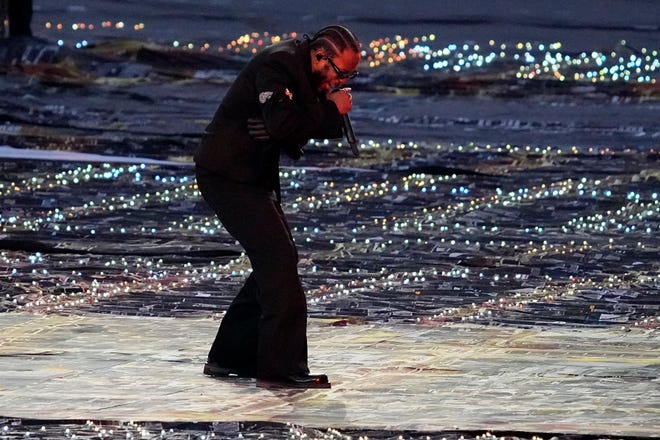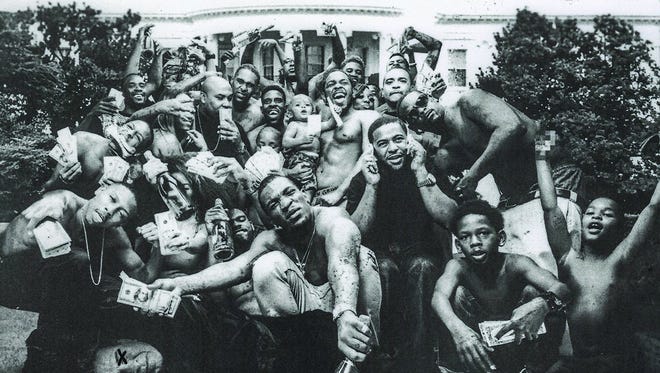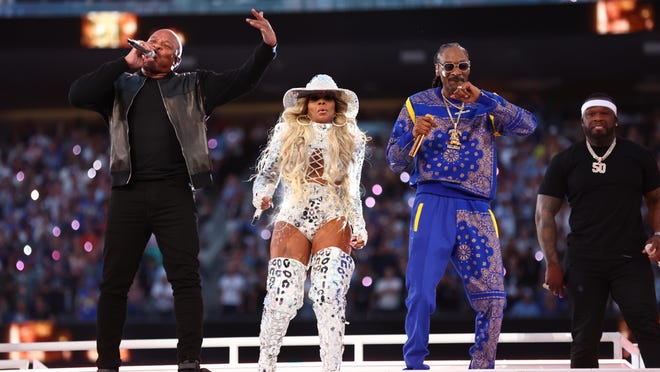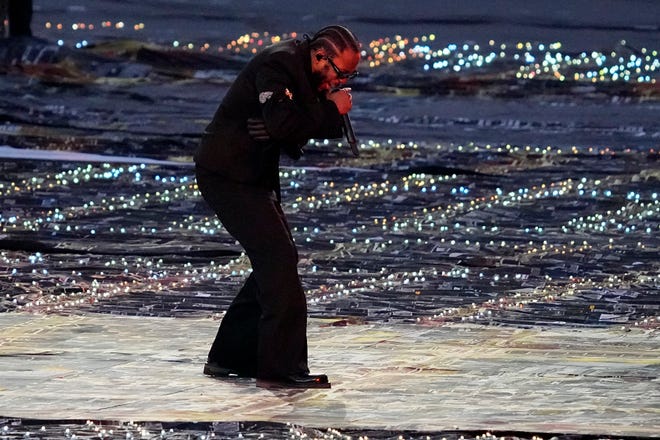Many Kendrick Lamar enthusiasts will be waiting for the clock to strike midnight to get a first listen at his highly anticipated “Mr. Morale & The Big Steppers” album.
The Compton-born rapper’s fifth studio album (out Friday) has been mostly under wraps, with cover art released a little more than 24 hours ahead of the release (which hints that he might be a father of two now) and no advance streams offered to journalists. But a few details have emerged: It will be his last album with his label Top Dawg Entertainment, it will come with a new, mysterious alter ego Oklama, and the album’s first single, “The Heart Part 5,” falls in line with the timely and poignant messaging of his old hits as he takes on the identities of Will Smith, OJ Simpson and more.
“I feel joy to have been a part of such a cultural imprint,” Lamar posted on his website in August, referencing Top Dawg and using the Oklama pseudonym. “May the Most High continue to use Top Dawg as a vessel for candid creators. As I continue to pursue my life’s calling.”
Halftime show review:Eminem, Mary J. Blige, Snoop, Dre, Kendrick Lamar provide fiery mix in Super Bowl halftime show
Music critics and hip-hop buffs will be itching to put their thumb on what K.Dot or King Kendrick or Kung Fu Kenny has up his sleeve for his next era of music, or his “life’s calling,” but until then, they can only lean on what Lamar, 34, has previously released.
Here’s a look at the projects that made the rapper a 14-time Grammy winner:

Kendrick Lamar presents ‘Section .80’ as his ‘warm-up’ lyrical diary
Lamar’s debut came on the heels of several widely circulated mixtapes, releasing 2011’s “Section .80” as a well-received iTunes exclusive.
The jazzy, yet punk rock album, which ran just under an hour, mostly relied on Lamar and his thoughts on his Compton environment. Many verses explore how being born in the ’80s affected the life journey of his peers.
Lamar didn’t consider the 15-track project an album, but instead called it a “warm-up,” using “Section .80” as a lyrical diary for his observations on religion, drug use and insecurity.
‘damn.’:Kendrick Lamar wins Pulitzer Prize for music
“‘Section .80’ was more about the people, my debut album will be more about me. I know what I have to do and what I have to talk about, so there’s really no pressure,” Lamar told Billboard two months after its release.
‘Good Kid, mAAd city’ follows Kendrick Lamar’s evolution from Compton teen to ‘king’
Lamar remained true to his promise of creating an album “more about” him, introducing listeners to an adolescent version of himself in 2012’s “Good Kid, mAAd City.”
The narrative album’s double cover features a Polaroid of young Lamar sitting with male family members and its bonus cover depicts his family van, which is referenced throughout, as he borrows it to hang with friends and pursue a love interest.
“Good Kid” follows teenage Lamar as he balances virginity, peer pressure, street violence and pestering voicemails from his parents: “Kendrick, just bring my car back.”
Lamar’s friends address him as K.Dot throughout the album as he navigates the dangers of drive-bys, drugs and alcohol use in “The Art of Peer Pressure” and “Swimming Pools (Drank)” until eventually stumbling toward salvation in “Sing About Me, I’m Dying of Thirst.”
At the album’s conclusion, Lamar’s fame is realized in “Compton” when he’s joined by fellow hometown legend Dr. Dre. The young teen who was once K.Dot reintroduces himself as a fully realized 25-year-old star: “King Kendrick Lamar.”
The title was sealed when he entered the Grammy Awards with seven nominations that year, including album of the year and best new artist.
“I knew that some day I would be in this position, and I wanted to tell different stories of coming from the inner city,” Lamar told USA TODAY in 2012 of “Good Kid.” “Especially about young kids trying their best to stay away from the gang experience.”
‘To Pimp A Butterfly’ Solidifies Kendrick Lamar’s Socially Aware Songwriting
After a few years of silence from Lamar, he returned with a surprise Funkadelic-influenced jazz and soul album that solidified the rapper’s socially conscious style with themes of temptation, fame, colorism and incarceration within the Black community.

The album cover features shirtless Black men and young boys flexing chains and stacks of money in front of the White House while stepping on top of a white politician (who might be Ronald Reagan, referred to often in the rapper’s earlier songs about the demise of the ’80s).
Laced throughout the album are pieces of poetry that describe Lamar’s “survivor’s remorse” for leaving Compton. While most of “Butterfly” is heavy, the project also includes his bone-chilling yet uplifting “Alright” and self-love single “i.”
“This for hip hop,” Lamar said in his 2016 best rap album Grammy acceptance speech before naming off the greats before him. “We will live forever, believe that. All right?”
‘DAMN.’ celebrates Lamar’s rap mastery juxtaposed with his fictional death
The last full album Lamar gave fans was 2017’s “Damn,” which includes one-word songs stylistically similar to its title: “Blood,” “DNA,” “Element” and Rihanna-enhanced “Loyalty.”
Following the somber jazz and funky educational feel of “Butterfly,” “DAMN.” came with a much more upbeat exploration of his relationships with his family, neighborhood and other rappers, while also tackling the specter of death. The first song, “Blood,” ends with Lamar being shot.
Kendrick Lamar’s ‘DAMN.’:A track-by-track instant review
In “DAMN.,” Lamar also introduces a new ego for himself: Kung Fu Kenny, who told Complex was “a master of the craft” of songwriting and music in 2017.
Not only did “DAMN.” win five Grammys, it earned a 2018 Pulitzer Prize for being “a virtuosic song collection unified by its vernacular authenticity and rhythmic dynamism … capturing the complexity of modern African-American life.”
“DAMN.” closes with “Duckworth.,” which tells a true story of how Top Dawg Entertainment’s CEO once planned to rob a KFC where Lamar’s father worked and decided to spare his life from him.
Lamar raps at the end before a gunshot sounds off: “Because if Anthony (Tiffith) killed Ducky (Kenny Duckworth), Top Dawg could be servin’ life, while I grew up without a father and die in a gunfight.”
Could’Mr. Morale’ allow Lamar life after fictional death?
Leaving the last record with the idea of Lamar dying makes space for “Mr. Morale” to be picked up in the afterlife. Lamar writes from an otherworldly place, hinting toward completion and separation from the rest of the world as a heavenly body.
“Thank you for keeping me in your thoughts. I’ve prayed for you all,” Lamar wrote on his Oklama website. “See you soon enough.”
On the “Mr. Morale” album cover, Lamar wears a Jesus-like crown of thorns, with a baby in his arms and a handgun in his waistband. In his single “The Heart Part 5,” he eulogized himself, sending a last message to his loved ones in the final verse.
“To my brother, to my kids, I’m in Heaven / To my mother, to my sis, I’m in Heaven / To my father, to my wife, I am serious, this is Heaven,” Lamar raps. “And to the killer that sped up my demise, I forgive you, just know your soul’s in question.”
In “Mr. Morale,” maybe fans can expect a savior-like Lamar: Oklama.
Contributing: Patrick Ryan and Maeve McDermott

